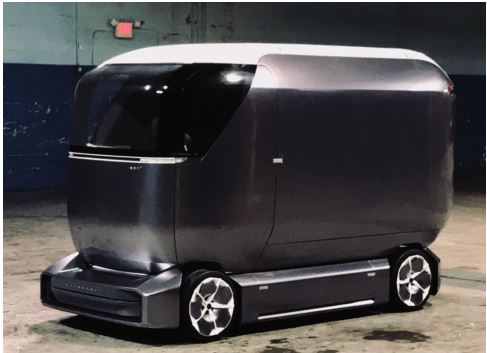Quadrobot van ready to make its move in automated delivery


The race to market automated delivery vehicles is heating up, and a company started by a Chinese native is poised to be a disrupter of the way goods and services are transported worldwide.
Shipping giant FedEx Corp this week unveiled an automated delivery robot that the company hopes will be transporting packages to various locations soon. Closely observing this was Mike Tianye Wang, the CEO of Quadrobot, a company in suburban Detroit that by the end of this year will deploy about 2,000 electrically powered, self-driving delivery vans in China and the US.
In China, the boxy vehicles will deliver the mail, while in metro Detroit, the vehicles will pickup and deliver packages.
"I came to Detroit about 10 years ago to study car design," said Wang who was raised in Hangzhou, Zhejiang province. "Eventually I worked in design with Fiat Chrysler."
In 2017, Wang said he wanted to develop vehicles that could take advantage of electrification as a power source rather than the internal combustion engine that uses gasoline and other fuels. Working at Fiat Chrysler, he wanted to change the manufacturing process.
He saw that the traditional manufacturing or assembly process consumed a lot of money and energy.
"My initial idea was to change the manufacturing method to reduce the use of welding and the stamping (fabricating) of metals," Wang said.
Raising $5 million from investors, Wang started Quadrobot to design a vehicle around electrification and to simplify the manufacturing process into modules.
"We put the modules together with bolts, glue and screws (instead of welds) and by doing that, the assembly process costs much less than the traditional process," he said.
Wang's company plans to hire about 50 workers later this year to begin assembling the Quadrobot U1, a four-wheel-drive delivery van, in a Detroit suburb. The U1 has 35 kilowatts of power, about 47 horsepower and can travel up to 200 miles on a single charge. The maximum speed it can attain is about 50 miles per hour.
The modules and related components will be made in China, but the final assembly of the vehicle will occur in the country where the U1s will operate. That is another advantage of the assembly system, Wang said.
"This can also be applied to bigger vehicles that use up 350 kilowatts of power that can travel farther and faster (such as a passenger car)," he added.
Wang said his company is on the verge of raising another $150 million from investors in China and the US – mainly in Michigan and Silicon Valley to fund more expansion.
Although the Quadrobot U1 is capable of operating without a human driver, the test vehicles in China and Detroit will have drivers "until regulations in China and the US allow autonomous operation", said Wang.
Lionel Robert, a robotics professor at the University of Michigan, said more vehicles like this can be expected to operate in China and the US in the next two years.
"There are several barriers that the technology has to overcome, such as bad weather and densely populated areas with pedestrians and bicyclists," Robert said. "The more stable and predictable the driving environment, the more likely we are to see automated vehicles, and the more dynamic and unpredictable the environment, the less likely we are to see automated vehicles."
John Wen of the engineering department at Rensselaer Polytechnic Institute in Troy, New York, said the robot mail-delivery trucks represent a good first step for self-driving vehicle deployment.
"These types of deployments in more controlled environments will be increasingly common, including in industrial, manufacturing and commercial facilities," said Wen.
Robert believes that in the future, the vehicles also may be deployed to provide mobile meeting space, retail storefronts and medical clinics.
































